AGRONOMIC UPDATE – August 23, 2023….Old-Time August Blowtorch….
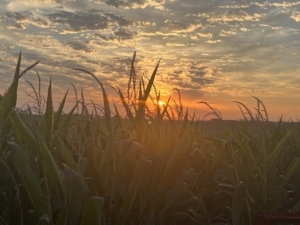
Last few days we’ve experienced an old-time August heatwave and blowtorch….
Topics:
- Growing Degree Unit Update/Weather Forecast
- Crop Update – Water, Disease
- Corn/Soybean Insect Update
TEMPERATURES & GDU ACCUMULATION:
As of August 22nd, we have accumulated approximately the following for Growing Degree Units in 2023:
Planting Date GDD’s2023 Average GDD Departure from average
April 21 2403 2371 +33 (+ 1.5 days)
April 28 2359 2359 +47 (+1.5 days)
May 9 2228 2203 +25 (+ 1 day)
June 5 1770 1839 -69 (-2.5 days)
Since the last update on August 14th, we have gained 1-2 days over the normal which stands to reason for the heat we’ve been experiencing. I put the June date in the table for those acres that were planted following rye, etc.; here we still run 2-3 days behind normal which is somewhat of a concern as we head into September both for frost and just overall grain fill.
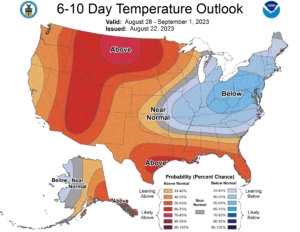
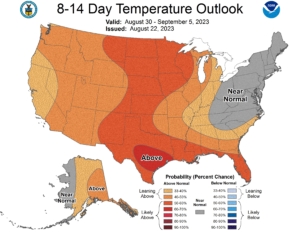
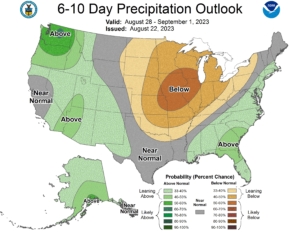
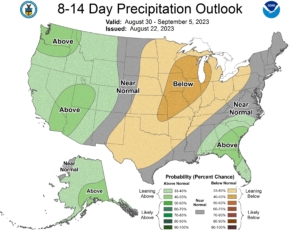
The above maps show the 6-10 and 8-14 day temperature and precipitation forecasts. After a brief cool down this weekend, the short term forecasts are for higher than normal temps and with below normal precip. In other words, what we saw for much of June. This will help keep the crop moving and provide good solar radiation, but timely irrigation will still have to be in the mix over the next couple of weeks.
Crop & Weather Update:
- Much of the corn crop in the area is at 1/8 to 1/4 to 1/3 milk line depending upon planting date and hybrid maturity. This is similar to slightly ahead of 2022. Soybeans are in the R6 (Full Seed) stage with some early planted plus early maturity varieties starting to get that off green color. For the most part the irrigated crop has weathered the heat pretty well so far….dryland, another story….
- Temperature forecasts over the next 15 days (out to Sep 6) are predicted to give us 350-370 GDU’s. Add this to the above GDU numbers and we have the April planting date showing over 2700 GDUs and the May 9 showing over 2600. These numbers are enough to mature much of the 103-111 day maturities. However, with the cooler temps at planting time delaying emergence, I would not expect fields to be mature on these dates even though the GDU accumulation says it should be….besides the longer we can extend grain fill, the heavier the test weights and the deeper the kernel which all adds up to increased yield….and better standability for harvest…. At this rate, harvest could come quicker than one thinks….
- Something to keep in mind as we finish out the next few weeks…. for 250-300 bu. each day from R4 (Dough) to the end is worth 3.5-4 bushels. At half milk line (R5.5), it’s still accumulating up to 2 bu/day of kernel weight. At R5.5, you want to see green stalks to the ground, and green leaves from the ear to the top of the plants. In other words, the goody (or ‘how much profit’) is still being determined over these weeks….don’t shutoff to early…
- Sunlight has greatly improved over the last 7-10 days. We are running 3-5% above normal for solar radiation during this time period. This should be very positive for test weights and plant health (keep in mind here the green stalks and leaves from above comment). So far, early grain color looks good, so this is good sign for test weight and overall grain quality.
- Water needs: As expected, ET rates for corn and soybeans have been higher than normal over the past week, averaging .35-.36/day. This is .08-.09/day higher than average. The past two high heat days alone have been .40+/day. Thankfully we received the rains we did in July or we would not have been able to get through the past week or so. This has been really hard on the dryland, both corn and soybeans. Below chart shows total water needs for corn during these last growth stages.
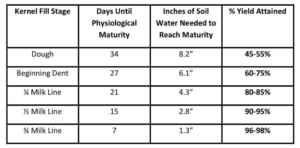 One positive is that most irrigated soil moisture profiles in the heavy soils are in good shape if irrigation has occurred over the past week….this means not that many circles are left, but we don’t have enough in the profile to finish the crop like we would want it to finish. At R6, soybeans still need 2-3 inches of water to finish and they have been pulling harder than corn. All of these figures are dependent upon temperature and humidity.
One positive is that most irrigated soil moisture profiles in the heavy soils are in good shape if irrigation has occurred over the past week….this means not that many circles are left, but we don’t have enough in the profile to finish the crop like we would want it to finish. At R6, soybeans still need 2-3 inches of water to finish and they have been pulling harder than corn. All of these figures are dependent upon temperature and humidity. 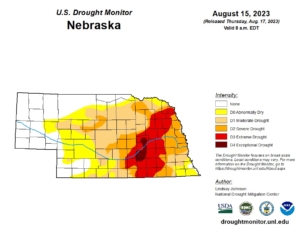
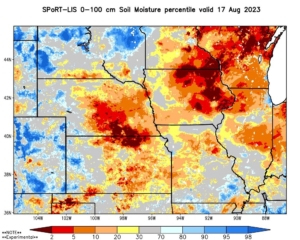 These two maps show the latest drought monitor map for Nebraska and soil moisture percentile deficit for the western corn belt. While this is just FYI, please note that, while drought conditions have improved, our subsoil profile overall is still below normal for much of Nebraska and Iowa and the north eastern corn belt.
These two maps show the latest drought monitor map for Nebraska and soil moisture percentile deficit for the western corn belt. While this is just FYI, please note that, while drought conditions have improved, our subsoil profile overall is still below normal for much of Nebraska and Iowa and the north eastern corn belt.- Disease Update: Corn – overall leaf disease pressure continues to be minimal, however, Goss’s Wilt has increased over the past two weeks, mainly in those areas hit with hail and wind back in July, but is starting to show up in other areas as well. Bacterial Leaf Streak has slowed down over the past few weeks. We have not observed any Tar Spot in the area as of yet. Northern Corn Leaf Blight is still active in low amounts in those hybrids that are less tolerant to the disease. Other than the hailed areas, most of these diseases are coming in late enough to have very little impact on yield. Soybeans – White Mold continues to spread throughout much of the area, in both heavy and sandy soils. Disease is showing up mainly in lower areas of the field and those areas and varieties prone to lodging. Some fields are pretty heavily infested. As in the past, many factors influence this disease such as planting date, early irrigation, fungicide application and/or timing, and varietal tolerance. SDS also continues to increase in the area. Again, many factors influence this disease such as soil conditions at planting, early stress that hampers root development and varietal tolerance. High-rate Ilevo seed treatment works very well on this disease….we see very low levels of SDS in those fields treated for SDS.
Corn & Soybean Insect Update
- Spider Mites are starting to increase in area corn fields, especially those treated with for corn rootworm beetles, etc. Keep an eye on this insect as there are a couple of isolated fields that are showing heavier pressures. This insect really blew up quickly with the hot and drier conditions. Most area fields (and crop maturity) should be fine; however, this insect bears monitoring as they can increase in population quickly under these conditions. If you are finding colonies up to the ear leaf or higher and plants are starting to wither because of the insect, treatment may be warranted yet depending upon stage of growth of the crop. See link for more info: Spider Mite Management in Corn
- Dectes Stem Borer numbers in area fields are higher than they have been in the past. In fact, some areas that appear to be SDS have more damage from this insect than the disease. This insect will be heaviest on field borders, and main impact from this insect is loss of yield at harvest time from stems breaking off and no longer able to be harvested. This year we are seeing the heaviest levels and most widespread area that we have yet seen out of this insect in our area. Best management practice is early harvest before the stems get dry and brittle, keep this in mind as harvest nears. See the link for more info: Dectes Stem Borer in Soybeans
Reminder that the Pioneer Plot Tour is scheduled for Wednesday evening, August 3oth with meal @ 6:30pm and plot tour @ 7pm. Please contact us with any questions or concerns you may have. Thank you for the support!!
Starman Seed Service, Inc.

